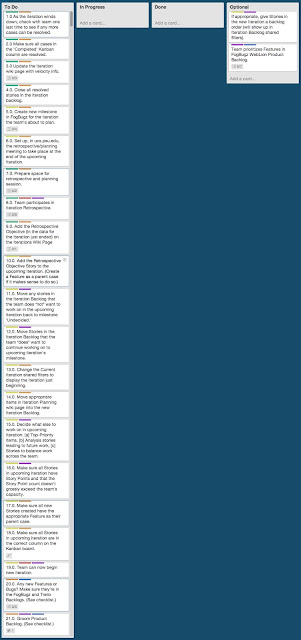Everyone likes to think that the meeting they're sitting in is productive and staying on track. One of the best things about using a Kanban system is that it provides a highly visual representation of your team's progress.
I've found that Trello works great for conducting meetings, work sessions, and other group activities. After all, what is a meeting but a short-duration collaborative project?
If you go into every meeting with an agenda—as you should—then you have a predefined set of items for the To Do column. Then it is a matter of simply moving them through the steps required to bring them to conclusion. Furthermore, you can use Trello features such as commenting and voting to capture all sorts of information during the session.
Here are a couple of the meetings and work sessions we handle using Trello:
The main part of our Iteration Planning is done by the entire team. Once that is completed, the Scrum Master takes care of a number of bookkeeping steps to get the Iteration underway.
We use four simple columns to track this work:
Our team runs Agile Retrospectives using the techniques described in James Shore's The Art of Agile Development: Retrospectives. Our Retrospective Trello board has just two columns:
I've found that Trello works great for conducting meetings, work sessions, and other group activities. After all, what is a meeting but a short-duration collaborative project?
If you go into every meeting with an agenda—as you should—then you have a predefined set of items for the To Do column. Then it is a matter of simply moving them through the steps required to bring them to conclusion. Furthermore, you can use Trello features such as commenting and voting to capture all sorts of information during the session.
Here are a couple of the meetings and work sessions we handle using Trello:
Agile Iteration Planning
The main part of our Iteration Planning is done by the entire team. Once that is completed, the Scrum Master takes care of a number of bookkeeping steps to get the Iteration underway.
We use four simple columns to track this work:
- To Do
- In Progress
- Done
- Optional
- As the iteration winds down, check with team one last time to see if any more cases can be resolved.
- Make sure all cases in the 'Completed' Kanban column are resolved.
- Update the Iteration wiki page with velocity info.
- Close all resolved stories in the Iteration Backlog.
- Create new milestone in FogBugz for the iteration the team's about to plan.
- Set up, in our calendaring system, the retrospective/planning meeting to take place at the end of the upcoming Iteration.
- Prepare space for retrospective and planning session.
- Team participates in Iteration Retrospective.
- Add the Retrospective Objective (in the data for the Iteration just ended) on the Iterations Wiki Page
- Add the Retrospective Objective Story to the upcoming Iteration. (Create a Feature as a parent case if it makes sense to do so.)
- Move any stories in the Iteration Backlog that the team does *not* want to work on in the upcoming iteration back to milestone 'Undecided.'
- Move Stories in the Iteration Backlog that the team *does* want to continue working on to upcoming iteration's milestone.
- Change the Current Iteration shared filters to display the iteration just beginning.
- Move appropriate items in Iteration Planning wiki page into the new Iteration Backlog.
- Decide what else to work on in upcoming Iteration: [a] Top-Priority items, [b] Analysis stories leading to future work, [c] Stories to balance work across the team.
- Make sure all Stories in upcoming Iteration have Story Points and that the Story Point count doesn't grossly exceed the team's capacity.
- Make sure all new Stories created have the appropriate Feature as their parent case.
- Make sure all Stories in upcoming Iteration are in the correct column on the Kanban board.
- Team can now begin new iteration.
- Any new Features or Bugs? Make sure they're in the FogBugz and Trello Backlogs. (See checklist.)
- Groom Product Backlog. (See checklist.)
- If appropriate, give Stories in the new Iteration a backlog order (will show up in Iteration Backlog shared filters).
- Team prioritizes Features in FogBugz Product Backlog.
Labels
We use Trello's labels to indicate if the task is done by the team or the facilitator, and whether the task is related to the previous Iteration, the upcoming Iteration, or the Product Backlog.
Agile Retrospective
Our team runs Agile Retrospectives using the techniques described in James Shore's The Art of Agile Development: Retrospectives. Our Retrospective Trello board has just two columns:
- To Do
- Done
- Facilitator posts column-header cards on wall.
- Team posts cards with activities, experiences under columns.
- Facilitator marks each team card with column symbol and removes column-header cards.
- Affinity mapping: team groups its cards into emerging categories.
- Facilitator and team label each category.
- Team members vote on categories.
- Team members vote on a single card in winning category; card becomes retrospective objective.
- Team brainstorms on how to address retrospective objective.
- One team member volunteers to take ownership of retrospective objective.
- Facilitator makes sure retrospective objective.
See these two Trello boards:

